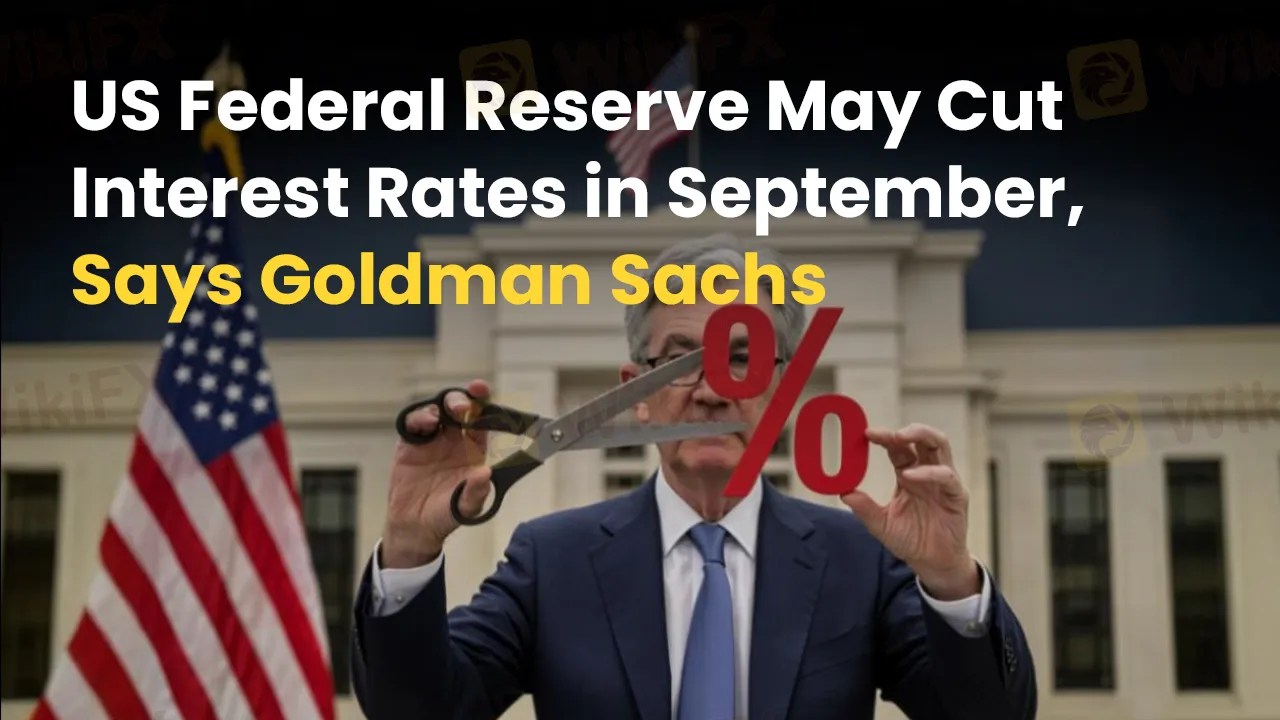简体中文
繁體中文
English
Pусский
日本語
ภาษาไทย
Tiếng Việt
Bahasa Indonesia
Español
हिन्दी
Filippiiniläinen
Français
Deutsch
Português
Türkçe
한국어
العربية
US Federal Reserve May Cut Interest Rates in September, Says Goldman Sachs
Abstract:US Federal Reserve Chair Jerome Powell may slash the policy rate in September 2025, according to research economists at Goldman Sachs. Read this to learn more.

US Federal Reserve Chair Jerome Powell may slash the policy rate in September 2025, according to research economists at Goldman Sachs. The latest forecast advances the rate cut expectation period by three months. Goldman Sachs Research made a change to its early forecast amid the smaller effects of tariff policies and stronger disinflationary forces. Goldman Sachs reckons that the Federal Reserve Meeting will align with its economists view that there will only be a one-time effect on price levels due to tariffs.
Fears of Softening Job Market Call for Rate Cuts Earlier Than Expected
Goldman Sachs Research pointed out the signs of a softening US job market. David Mericle, Chief US economist in Goldman Sachs Research, David Mericle, expressed that despite a healthy labor market, finding a job has become difficult. Downside risks to payroll figures in the near term also stems from the immigration policy changes and residual seasonality in the data.
When and How Much Rates Will the Fed Cut?
Mericle points out a 25-basis-point cut expectation in September, October and December, besides the same magnitude of rate cuts in March and June 2026. No rate cut expectations are for July 2026. Goldman Sachs Research estimates a terminal rate of 3-3.25% compared to 3.50%-3.75%. Mericle acknowledges that the Goldman Sachs team had anticipated the long-run dot plot of the Federal Open Market Committee to be a little higher. They also want the Federal Reserve Meeting to state that a modestly greater terminal funds rate than long-run neutral is feasible amid unusually high fiscal deficit and easy financial conditions owing to strong risk sentiment.
However, the dot plot remained unchanged in June, and a new Fed chair after the end of the term of the existing chair Jerome Powell, next year, may not believe that robust risk sentiment and large deficits should keep the funds rate higher.
A Look into Inflation and Unemployment in the US
According to Mericle, some Fed officials indicate they could extend support to the cut in the Federal Reserve Interest Rate Meeting in September should inflation prints remain under control. Category-level PCE data demonstrate a less effect from the earlier China tariffs. Survey evidence and alternative data hinted at somewhat less pass-through to consumers in the form of higher prices than the assumption made by Goldman Sachs Research.
Also, an earlier rise in Michigan and Conference Board inflation expectations does not appear to be a roadblock to a rate cut before. Also, signs of disinflationary pressures are apparent. The moderate growth in wages and weak travel demand have contributed to additional disinflationary pressure.
Employment-wise, there is a problem as vacancies have begun to shrink again. Mericle pointed out that although Fed officials have put in their best efforts to set the bar higher for cutting interest rates than in 2019, any weakness in the forthcoming employment report could prompt the Fed Meeting to come up with successive interest rate cuts for some time.
Disclaimer:
The views in this article only represent the author's personal views, and do not constitute investment advice on this platform. This platform does not guarantee the accuracy, completeness and timeliness of the information in the article, and will not be liable for any loss caused by the use of or reliance on the information in the article.
Read more

IMF Warns of Global Risks as US Slaps 50% Tariffs on Import
The IMF warns of rising global uncertainty after the US imposes a 50% tariff on copper and Brazil imports. Factories worldwide brace for economic fallout.

FCA’s Tech Crackdown Suspends 1,600+ Financial Sites
The FCA’s 2024 report details a tech-driven crackdown on financial crime, suspending 1,600+ sites and increasing firm authorisation cancellations in the UK.

FCA’s Tech Crackdown Suspends 1,600+ Financial Sites
The FCA’s 2024 report details a tech-driven crackdown on financial crime, suspending 1,600+ sites and increasing firm authorisation cancellations in the UK.

No License, No Security: CNMV Issues List of 10 Illegal Firms
Spain's financial watchdog, the National Securities Market Commission (Comisión Nacional del Mercado de Valores, CNMV), has issued warnings against 10 unlicensed forex brokers operating without proper authorization.
WikiFX Broker
Latest News
Alchemy Markets Review 2025: Key Facts and Insights
Largest Market Makers
Temasek's portfolio scales new peak even as divestments hit over 2-decade high
Exposing Trade Capital Limited - Siphoning Millions, Restricting Withdrawals, Charging Extra Fees
GMI Edge: A Closer Look at Its Licenses
How Do I Place a Stop-loss Order?
5 Serious Warnings About Mirrox! You Can’t Afford to Ignore
FXPRIMUS: 5 Things They Don’t Want You to Know
Manual vs. Automated Forex Trading: Which One Should You Choose?
Mining firms lift FTSE 100 to record high after Trump confirms 50% copper tariff
Currency Calculator


